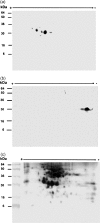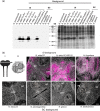Pollination in Nicotiana alata stimulates synthesis and transfer to the stigmatic surface of NaStEP, a vacuolar Kunitz proteinase inhibitor homologue
- PMID: 18689443
- PMCID: PMC2504342
- DOI: 10.1093/jxb/ern175
Pollination in Nicotiana alata stimulates synthesis and transfer to the stigmatic surface of NaStEP, a vacuolar Kunitz proteinase inhibitor homologue
Abstract
After landing on a wet stigma, pollen grains hydrate and germination generally occurs. However, there is no certainty of the pollen tube growth through the style to reach the ovary. The pistil is a gatekeeper that evolved in many species to recognize and reject the self-pollen, avoiding endogamy and encouraging cross-pollination. However, recognition is a complex process, and specific factors are needed. Here the isolation and characterization of a stigma-specific protein from N. alata, NaStEP (N. alata Stigma Expressed Protein), that is homologous to Kunitz-type proteinase inhibitors, are reported. Activity gel assays showed that NaStEP is not a functional serine proteinase inhibitor. Immunohistochemical and protein blot analyses revealed that NaStEP is detectable in stigmas of self-incompatible (SI) species N. alata, N. forgetiana, and N. bonariensis, but not in self-compatible (SC) species N. tabacum, N. plumbaginifolia, N. benthamiana, N. longiflora, and N. glauca. NaStEP contains the vacuolar targeting sequence NPIVL, and immunocytochemistry experiments showed vacuolar localization in unpollinated stigmas. After self-pollination or pollination with pollen from the SC species N. tabacum or N. plumbaginifolia, NaStEP was also found in the stigmatic exudate. The synthesis and presence in the stigmatic exudate of this protein was strongly induced in N. alata following incompatible pollination with N. tabacum pollen. The transfer of NaStEP to the stigmatic exudate was accompanied by perforation of the stigmatic cell wall, which appeared to release the vacuolar contents to the apoplastic space. The increase in NaStEP synthesis after pollination and its presence in the stigmatic exudates suggest that this protein may play a role in the early pollen-stigma interactions that regulate pollen tube growth in Nicotiana.
Figures









Similar articles
-
NaStEP: a proteinase inhibitor essential to self-incompatibility and a positive regulator of HT-B stability in Nicotiana alata pollen tubes.Plant Physiol. 2013 Jan;161(1):97-107. doi: 10.1104/pp.112.198440. Epub 2012 Nov 13. Plant Physiol. 2013. PMID: 23150644 Free PMC article.
-
SIPP, a Novel Mitochondrial Phosphate Carrier, Mediates in Self-Incompatibility.Plant Physiol. 2017 Nov;175(3):1105-1120. doi: 10.1104/pp.16.01884. Epub 2017 Sep 5. Plant Physiol. 2017. PMID: 28874520 Free PMC article.
-
NaStEP, an essential protein for self-incompatibility in Nicotiana, performs a dual activity as a proteinase inhibitor and as a voltage-dependent channel blocker.Plant Physiol Biochem. 2020 Jun;151:352-361. doi: 10.1016/j.plaphy.2020.03.052. Epub 2020 Mar 30. Plant Physiol Biochem. 2020. PMID: 32272353
-
Exocyst, exosomes, and autophagy in the regulation of Brassicaceae pollen-stigma interactions.J Exp Bot. 2017 Dec 18;69(1):69-78. doi: 10.1093/jxb/erx340. J Exp Bot. 2017. PMID: 29036428 Review.
-
What are the key mechanisms that alter the morphology of stigmatic papillae in Arabidopsis thaliana?Plant Signal Behav. 2021 Dec 2;16(12):1980999. doi: 10.1080/15592324.2021.1980999. Epub 2021 Sep 22. Plant Signal Behav. 2021. PMID: 34549683 Free PMC article. Review.
Cited by
-
Proteomics profiling reveals novel proteins and functions of the plant stigma exudate.J Exp Bot. 2013 Dec;64(18):5695-705. doi: 10.1093/jxb/ert345. Epub 2013 Oct 22. J Exp Bot. 2013. PMID: 24151302 Free PMC article.
-
Self-(In)compatibility Systems: Target Traits for Crop-Production, Plant Breeding, and Biotechnology.Front Plant Sci. 2020 Mar 19;11:195. doi: 10.3389/fpls.2020.00195. eCollection 2020. Front Plant Sci. 2020. PMID: 32265945 Free PMC article. Review.
-
NaStEP: a proteinase inhibitor essential to self-incompatibility and a positive regulator of HT-B stability in Nicotiana alata pollen tubes.Plant Physiol. 2013 Jan;161(1):97-107. doi: 10.1104/pp.112.198440. Epub 2012 Nov 13. Plant Physiol. 2013. PMID: 23150644 Free PMC article.
-
Physical mapping of a pollen modifier locus controlling self-incompatibility in apricot and synteny analysis within the Rosaceae.Plant Mol Biol. 2012 Jun;79(3):229-42. doi: 10.1007/s11103-012-9908-z. Epub 2012 Apr 6. Plant Mol Biol. 2012. PMID: 22481163
-
Pollen-Pistil Interactions and Their Role in Mate Selection.Plant Physiol. 2017 Jan;173(1):79-90. doi: 10.1104/pp.16.01286. Epub 2016 Nov 29. Plant Physiol. 2017. PMID: 27899537 Free PMC article. Review.
References
-
- Beecher B, McClure BA. Effects of RNases on rejection of pollen from Nicotiana tabacum and N. plumbaginifolia. Sexual Plant Reproduction. 2001;14:69–76.
-
- Bendtsen JD, Nielsen H, von Heijne G, Brunak S. Improved prediction of signal peptides: SignalP 3.0. Journal of Molecular Biology. 2004;340:783–795. - PubMed
-
- Bradford MM. A rapid and sensitive method for the quantitation of microgram quantities of protein using the principle of protein–dye binding. Analytical Biochemistry. 1976;72:248–254. - PubMed

